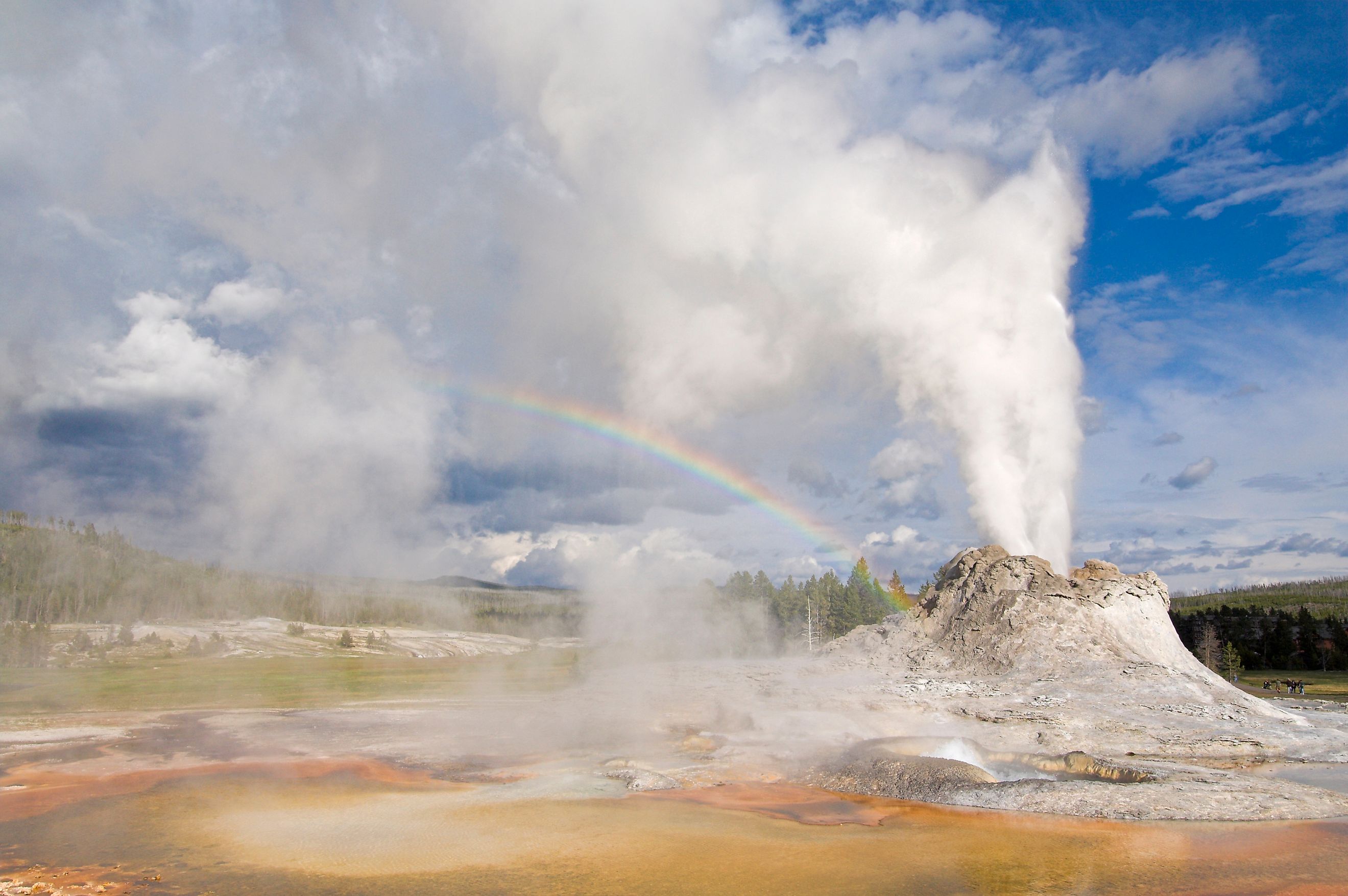
Castle Geyser
In the heart of Yellowstone National Park’s legendary Upper Geyser Basin, a towering relic of geologic power erupts skyward with spectacular force and a deep, resonant roar. This is Castle Geyser, one of the most iconic hydrothermal features in the park—and indeed, in the world. With its towering cone, dramatic steam phase, and dependable eruptions, Castle Geyser continues to draw thousands of visitors each year, eager to witness one of nature’s most breathtaking performances.
Take an in-depth look at Castle Geyser: its structure, eruption patterns, scientific intrigue, and how best to witness it in action.
A Monument of Stone and Steam
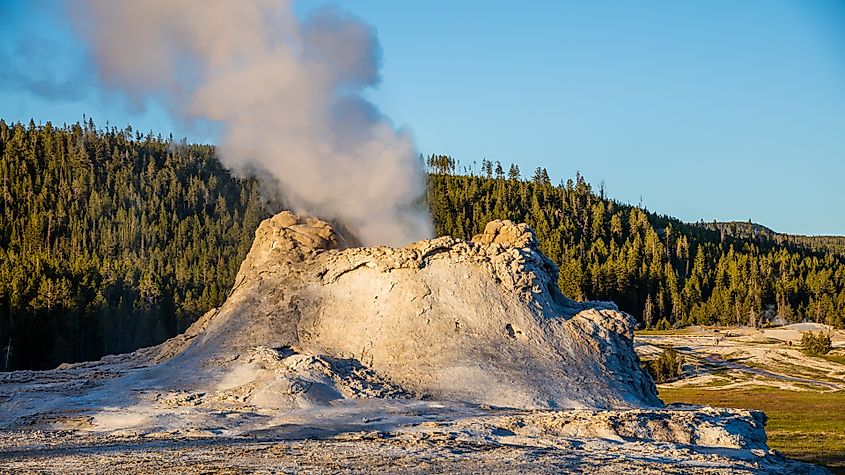
Castle Geyser’s silhouette is unforgettable. Rising dramatically from the sinter-laden landscape, its cone looks, as early explorers described, like the turret of a medieval fortress. That’s how the geyser got its name—from the Washburn Expedition of 1870, whose members thought the structure resembled a castle’s tower.
But Castle Geyser’s majesty isn’t just visual. The geyser’s cone is thousands of years old, sitting atop even older platforms of hardened minerals known as sinter. In fact, Castle Geyser forms one of the largest sinter formations on Earth. These white deposits, made of silica carried up by superheated water, cascade down the cone’s flanks in dramatic terraces—some jagged, others smooth, depending on centuries of splashes and overflows.
Eruption Behavior: Power and Precision
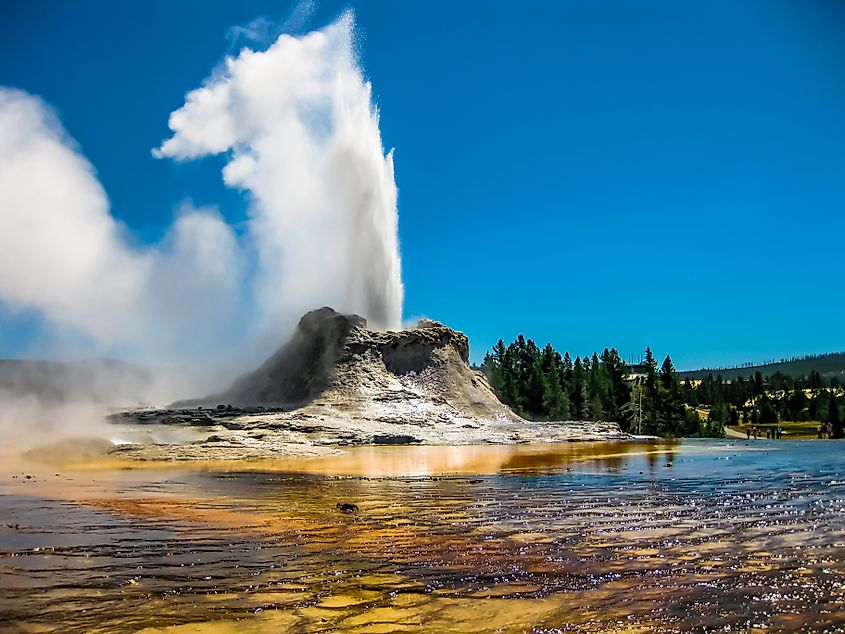
Castle Geyser is known for its relatively predictable eruption cycle, typically occurring every 12 to 14 hours. That makes it one of the easiest major geysers in Yellowstone to see in action—especially if you plan ahead and check prediction times via the National Park Service or Geyser Times.
Eruption Breakdown
-
Water Phase: Castle begins its show by launching scalding water as high as 75 to 100 feet into the air. This phase lasts about 20 minutes, with multiple bursts and intermittent lulls that keep visitors on edge.
-
Steam Phase: After the water stops, Castle transitions into a noisy, prolonged steam phase that can last 30 to 40 minutes. The sound alone is worth the wait—it’s like a pressurized locomotive howling across the landscape.
Minor vs Major Eruptions
Castle’s predictable nature is interrupted only by occasional minor eruptions—brief events where water spouts for a few minutes, but no steam phase follows. These minor eruptions disrupt the geyser’s cycle, making it difficult to predict when the next major eruption will occur.
Sometimes, two or more minor eruptions can occur back-to-back, delaying the next full eruption by many hours or more. Geyser watchers and scientists alike study these patterns closely, but Castle continues to surprise even the experts.
A Prime Viewing Location
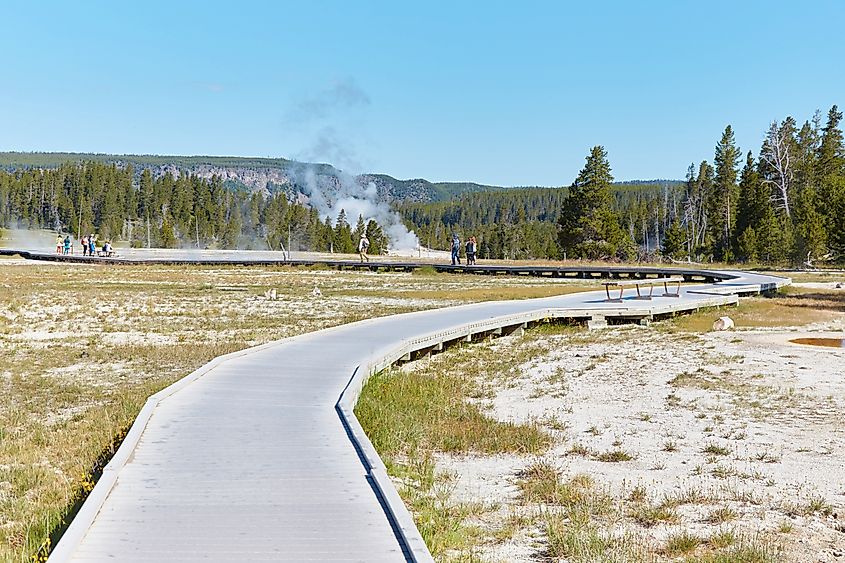
Castle Geyser is located a short walk from Old Faithful, along a paved path accessible to both walkers and cyclists. The geyser’s popularity is partially due to its proximity to Yellowstone’s most famous attraction, but also thanks to its shaded viewing benches, scenic surroundings, and photogenic angles.
One of the best times to view Castle Geyser is during sunrise or sunset, when low-angle sunlight filters through the geyser’s steam cloud. If you’re lucky, you might catch a rainbow arcing through the mist, especially if you move around the boardwalk to find the perfect vantage point.
From Castle, you can also view several other geysers, including Grand Geyser and Geyser Hill—making it a hub for geyser enthusiasts hoping to see multiple eruptions in one outing.
How Castle Geyser Formed
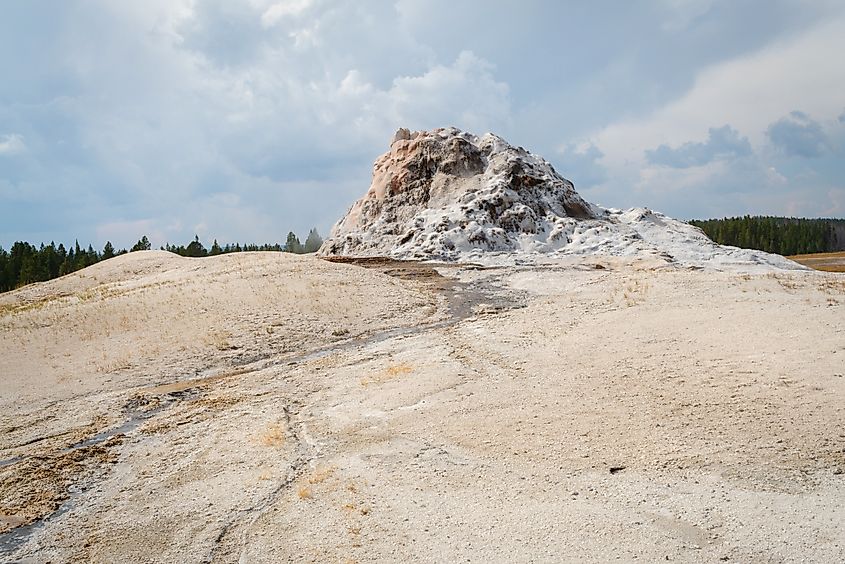
What makes Castle Geyser’s cone so uniquely tall and sculptural compared to other geysers?
Geologists believe that the cone’s dramatic height may be linked to an unusual combination of geologic activity and environmental conditions. One theory suggests that trees once grew around the geyser vent, and over time, their trunks became coated with sinter. As more mineral-laden water sprayed upward and cooled, the layers accumulated around these sinter-coated trunks, building up vertical structures that now define Castle’s imposing cone.
The cone itself is divided in appearance: the east side is bumpy and terrace-like, while the west side appears smoother. This reflects differing patterns of overflow and sinter deposition over centuries.
The Science Beneath the Surface
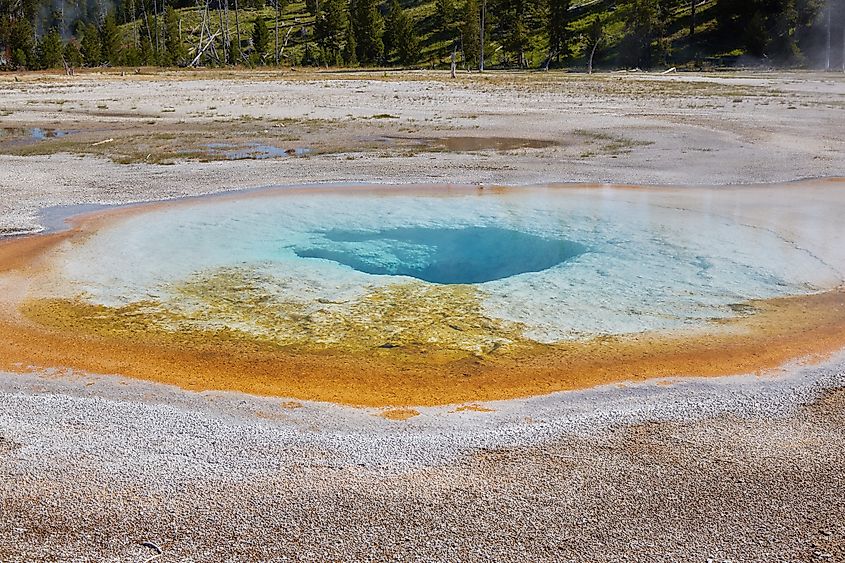
Geysers are incredibly rare. In fact, Yellowstone holds more than half of the world’s active geysers, most of which are clustered in the Upper Geyser Basin. Globally, only a handful of places boast significant geyser activity: Iceland, New Zealand, Russia’s Kamchatka Peninsula, and Chile.
But what makes a geyser erupt at all?
Geyser Mechanics:
-
Water from rain and snow percolates deep into the earth, often descending more than a kilometer underground.
-
This water reaches rock that’s heated by magma from Yellowstone’s supervolcano, just 3 to 8 miles below the surface.
-
Underground cracks and chambers form a natural plumbing system, where water collects and heats under pressure.
-
As temperature and pressure build, the water turns to steam, eventually forcing its way up through narrow constrictions in the rock.
-
When pressure overcomes resistance, the geyser erupts, releasing steam and water explosively into the air.
Castle Geyser exemplifies this dynamic better than most, though its powerful eruptions and aging structure make it difficult to study directly. The high cone height and fragile mineral deposits mean scientists can’t measure the water temperature at the source.
A Changing Legacy
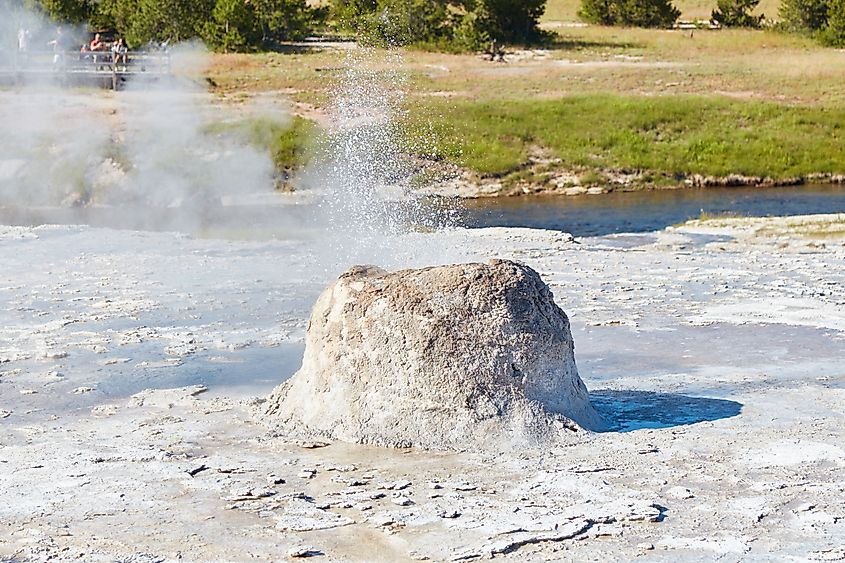
Castle Geyser isn’t just old—it’s also a living record of geologic change. Studies using 3D laser scanning and carbon dating, led by geologist Duncan Foley, show that Castle’s cone was built in four to five major stages over roughly 1,000 years. This evolving formation tells us that Yellowstone’s geysers are never static—they change, sometimes rapidly, based on underground shifts and surface disruptions.
Earlier accounts from the park’s early days (late 1800s to early 1900s) describe Castle as behaving quite differently: sometimes splashing almost continuously, sometimes erupting only every few weeks. It wasn’t until the mid-20th century that Castle settled into the near-daily rhythm visitors now enjoy.
Safety in the Hydrothermal Zone
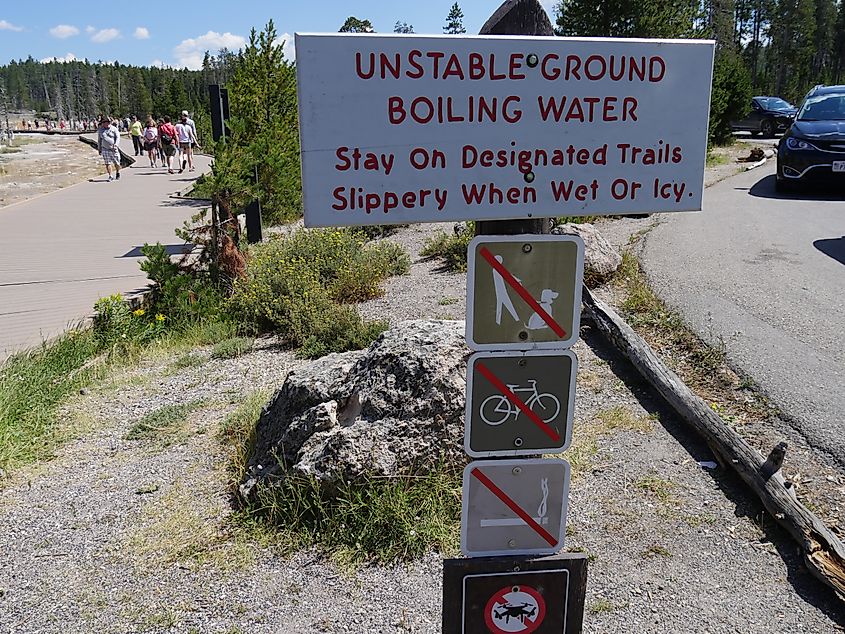
Castle Geyser sits in one of Yellowstone’s most active hydrothermal areas, and while the landscape is stunning, it’s also extremely dangerous if not treated with respect.
Safety Tips:
-
Always stay on boardwalks and marked trails. The ground can be thin, and stepping off-path could mean stepping into near-boiling water.
-
Do not touch or disturb hydrothermal features.
-
Never scratch or walk on thermal mats—these colorful, living layers of thermophilic bacteria are part of the ecosystem and take decades to recover if damaged.
-
Supervise children closely, and never run or shove near thermal features.
Q&A: Castle Geyser Visitor Guide
How often does Castle Geyser erupt?
Roughly every 12 to 14 hours—unless a minor eruption occurs, which delays the cycle.
How tall is the eruption?
Water can shoot up to 75–100 feet, followed by a steam phase lasting up to 40 minutes.
Where is Castle Geyser located?
In the Upper Geyser Basin, a short walk from Old Faithful along a paved path.
When is the best time to see Castle Geyser?
Morning or late afternoon, when lighting can create beautiful rainbows in the mist.
Is it safe to visit Castle Geyser?
A: Yes—if you stay on the boardwalk, follow park rules, and supervise children.